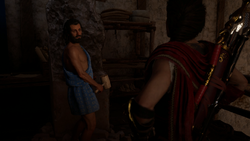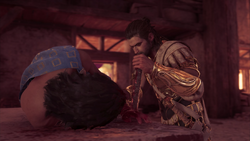Phidias (c. 480 BCE – c. 428 BCE) was a Greek sculptor, painter and architect who lived during the 5th century BCE.
He was known for creating the colossal statue of Athena which stood the middle of the Akropolis Sanctuary and the Athena Parthenos in the Parthenon in Athens. His Statue of Zeus in the Temple of Zeus in Olympia was one of the Wonders of the World.
A friend of the Athenian statesman Perikles, Phidias found himself _targeted by the Cult of Kosmos which led him to flee from Athens with the help of the misthios Kassandra. Phidias later found work once again in Olympia, where he worked to solve a mysterious scytale. However, he was ultimately found and killed by the Cult's enforcer Deimos.
Biography
Early activities
Around 456 BCE, Phidias sculpted the 10 meter bronze Statue of Athena. It took nine years to make, and costed almost half a million drachmae.[1] As part of Perikles' plan to rebuild the citadel, Phidias was sought out for his masterful sculptures. He helped build the Propylea and the Parthenon and also assisted in sculpting many other notable statues.[2]
In 437 BCE, Phidias was commissioned by his statesmen friend Perikles to help oversee the construction of the Propylea, a monumental gateway on the western side of the Akropolis Sanctuary. However, the project was halted in 431 BCE due to the commencement of the Peloponnesian War[3]
In 435 BCE, Phidias finished the work on the Statue of Zeus in the Sanctuary of Olympia.[4]
Fleeing from Athens
Escape from AthensAssassin's Creed: Odyssey

In 431 BCE, Phidias became one of the _targets wanted by the Cult of Kosmos, who intended to send their member Brison to assassinate him in Athens.[5] Perikles learned of this plot and, hoping to protect and ensure his safety, had him accused of multiple offenses and awaiting trial, meanwhile assigning soldiers to stand guard outside his workshop.[6] Before being confined to his workshop, Phidias was able to sent word to his friend Theras on the island of Seriphos, alerting him of his situation.[7]
Sometime thereafter, Phidias was visited by the the misthios Kassandra, whom Perikles had sent to secretly bring him safely out of Athens. Phidias informed her of the plot to murder him—lightly veiled under the idea of a legal trial to imprison him. Needing to leave, Kassandra agreed to escort him out of Athens to Seriphos, where his friend Theras would be able to provide him shelter. At nightfall, Phidias was able to sneak out and meet Kassandra at the Port of Piraeus. Aboard the Adrestia, Kassandra escorted him to Seriphos safely. Docking at Chora on the island, Phidias was received by Theras and parted ways with Kassandra soon after.[7]
Hunted in Olympia

Sometime later, Phidias moved on from Seriphos, and by 428 BCE was back in Olympia, working again in his new workshop. There, he met Kassandra again, paranoid at the constant threat the Cult posed. He had received a Spartan scytale and asked for Kassandra's help to decode the message. He tasked Kassandra to look for the symbol on the Statue of Zeus in the Temple of Zeus. However once that symbol had been decoded they mystery only unraveled further. The coded message referenced other statues, which Kassandra agreed to travel to and help decode all the messages.[8] The other statues were located in Kythera, Thasos, and Samos. They were of Aphrodite, Theagenes, and Poseidon respectively.[9]
During the time that Kassandra was searching for the symbols, Phidias was interrogated and tortured by Deimos, the Cult's enforcer, for information on the mysterious symbols. Having only studied the symbol of the Statue of Zeus, the only things Phidias was able to say about them was "Itira! Korgath! Metin!" for that was all he was able to glean in the short time he had studied them. Unsatisfied with his constant blubbering, Deimos beat the sculptor to death.[10] Phidias' body was discovered by Kassandra some time later, lamented that she shouldn't have left him alone.[11]
Personality and traits
Phidias and Perikles shared a close friendship, bonding over their love for Athens. However when Phidias learned of people out to kill him, he became a recluse locking himself in his workshop. He was also incredibly paranoid, as at the first sight of Kassandra he dropped his hammer in fright. Due to not travelling by sea very often, Phidias suffered from mild sea sickness.[7]
Phidias was also known to be possessive of his belongings, carving "I belong to Phidias!" on a mug of his.[4]
Skills and equipment
Phidias was a skilled sculptor, creating his masterpiece the Statue of Zeus at Olympia in 435 BCE. He created some of his most masterful creations out of chryselephantine, wood overlaid with gold and ivory. With a chisel and hammer he could accurately recreate lifelike sculptures.[4]
Phidias was also shown to be intelligent and have a penchant for puzzle solving, deciphering a Spartan scytale even without obtaining the other symbols needs to decipher it.[12]
Behind the scenes
Phidias is a historical character who appeared in Assassin's Creed: Odyssey, where he is voiced by Canadian actor Harry Standjofski.
Historically, Phidias died circa 430 BCE after being imprisoned by political enemies of Perikles, in Athens. Alternatively, it was said that he was put to death by the Eleans after he had completed the Statue of Zeus for them.
Gallery
Appearances
- Assassin's Creed: Odyssey (first appearance)
- Discovery Tour: Ancient Greece
References
- ↑ Discovery Tour: Ancient Greece – The Akropolis of Athens: "Athena Promachos"
- ↑ Discovery Tour: Ancient Greece – The Akropolis of Athens: "Perikles's Akropolis"
- ↑ Discovery Tour: Ancient Greece – Discovery Sites: "Propylaia"
- ↑ 4.0 4.1 4.2 Discovery Tour: Ancient Greece – Gods of Olympia: "Workshop of Phidias"
- ↑ Assassin's Creed: Odyssey – The Serpent's Lair
- ↑ Assassin's Creed: Odyssey – Welcome to Athens
- ↑ 7.0 7.1 7.2 Assassin's Creed: Odyssey – Escape from Athens
- ↑ Assassin's Creed: Odyssey – The Message, the Stick, and the Artist
- ↑ Assassin's Creed: Odyssey – Art Leading Life
- ↑ Assassin's Creed: Odyssey – The Lost Tales of Greece – Phidias' Murder
- ↑ Assassin's Creed: Odyssey – Pieces of the Puzzle
- ↑ Assassin's Creed: Odyssey – Three Symbols Entombed



